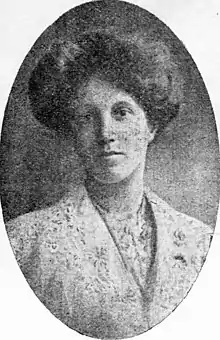
Lilian Sophia Locke (later Lilian Sophia Burns; 6 June 1869 – 1 July 1950) was an Australian trade unionist, political campaigner and suffragette.[1] She has been described as one of the earliest women leaders of the labour movement in Australia.[2]
She was variously president of the New South Wales Association of Women Workers, the "only lady member of the Melbourne Trades Hall Council", lady organiser for the Political Labor Council, and honorary secretary of the United Council for State Suffrage[3][4][5] In 1905, she was the first woman delegate to a Labor Party interstate conference, when she was accredited for Tasmania at the Commonwealth Political Labor Conference.[1][6] She regularly travelled Australia as an organiser for the Labor Party between the start of World War I and 1940.[2] Her skills were widely praised in the labor press: the Brisbane Worker labelled her a "brilliant organiser and propagandist", the Daily Standard in Brisbane described her as "one of the ablest women Labor platform exponents in the Commonwealth", while the Worker in New South Wales stated that "a great deal of the effectiveness of Mr. Burns' political activity must be credited to the splendid help accorded him by his wife, Lilian Locke Burns".[7][8][9] She was often described as being well-received and speaking to large audiences.[10][11][12] One visit to South Australia was credited with the foundation of the Women Employees' Mutual Association in that state.[13]
She married George Burns, then a Tasmanian state Labor politician, in Melbourne on 6 January 1906.[14][15]
She was also a keen writer who published work in magazines, and was reportedly "especially known by her short stories". She was a regular contributor to labour journal The Tocsin.[16][17][18]
Her father was the Rev. William Locke, an Anglican clergyman in Victoria, and her grandfather English reformer William Locke. She was born in Melbourne, one of ten girls; one of her sisters was the author Sumner Locke.[1] She was a friend of Vida Goldstein, having worked with her since the suffrage campaigns of the 1890s.[17][18][19][20]
A 1988 book, Silk and Calico: Class, Gender and the Vote, by Betty Searle, explored the first wave of the feminist movement in Australia through the lives of Locke, Goldstein and Rose Scott.[21]
References
- 1 2 3 "Locke, Helena Sumner (1881–1917)". Australian Dictionary of Biography. National Centre of Biography, Australian National University. ISSN 1833-7538. Retrieved 5 November 2016.
- 1 2 "Death Of Early Woman Labor Leader". The Advertiser. Vol. 93, no. 28, 620. Adelaide. 3 July 1950. p. 2. Retrieved 5 November 2016 – via National Library of Australia.
- ↑ "State Suffrage for Women". Portland Guardian. Vol. LXII, no. 5221. Victoria, Australia. 18 January 1904. p. 3 (EVENING). Retrieved 5 November 2016 – via National Library of Australia.
- ↑ "Victorian Notes". The Worker. Vol. 14, no. 13. New South Wales. 1 April 1905. p. 7.
- ↑ "A Woman Candidate". The Gosford Times and Wyong District Advocate. Vol. XXXV, no. 331. New South Wales. 3 May 1917. p. 6. Retrieved 5 November 2016 – via National Library of Australia.
- ↑ "THE AUSTRALIAN POLITICAL LABOR CONFERENCE". The Worker. Vol. 14, no. 35. New South Wales. 2 September 1905. p. 15. Retrieved 5 November 2016 – via National Library of Australia.
- ↑ "SOME LEADING LABOUR WOMEN". The Worker. Vol. 18, no. 839. Queensland. 1 June 1907. p. 13. Retrieved 5 November 2016 – via National Library of Australia.
- ↑ "MERELY PERSONAL". The Worker. Vol. 19, no. 8. New South Wales. 24 February 1910. p. 6. Retrieved 5 November 2016 – via National Library of Australia.
- ↑ "ITEMS ABOUT PEOPLE". Daily Standard. No. 3831. Queensland. 21 April 1925. p. 10 (SECOND EDITION--3 p.m.). Retrieved 5 November 2016 – via National Library of Australia.
- ↑ "MISS LILIAN LOCKE". The Herald. Vol. XII, no. 576. Adelaide. 21 October 1905. p. 7. Retrieved 5 November 2016 – via National Library of Australia.
- ↑ "MISS LILIAN LOCKE". The Barrier Miner. Vol. XVIII, no. 5310. New South Wales. 8 July 1905. p. 5. Retrieved 5 November 2016 – via National Library of Australia.
- ↑ "MISS LILIAN LOCKE". Zeehan and Dundas Herald. Vol. XV, no. 258. Tasmania. 11 August 1904. p. 2. Retrieved 5 November 2016 – via National Library of Australia.
- ↑ "SOUTH AUSTRALIA". The Worker. Vol. 14, no. 45. New South Wales. 9 November 1905. p. 5. Retrieved 5 November 2016 – via National Library of Australia.
- ↑ "Victorian Notes". The Worker. Vol. 14, no. 13. New South Wales. 1 April 1905. p. 7. Retrieved 5 November 2016 – via National Library of Australia.
- ↑ "Wedding". The Critic. Vol. IX, no. 432. Adelaide. 17 January 1906. p. 21. Retrieved 5 November 2016 – via National Library of Australia.
- ↑ "And The Color—It Was Red". The Gloucester Advocate. Vol. XXIX, no. 2640. New South Wales. 29 September 1933. p. 1. Retrieved 5 November 2016 – via National Library of Australia.
- 1 2 "WOMAN'S WORLD". The Mercury. Vol. CV, no. 14, 605. Tasmania. 28 October 1916. p. 10. Retrieved 5 November 2016 – via National Library of Australia.
- 1 2 "Locke, Lilian (1869 - 1950)". The Encyclopedia of Women and Leadership in Twentieth-Century Australia. Retrieved 5 November 2016.
- ↑ "PERSONAL". The Advertiser. Vol. XLVIII, no. 14, 736. Adelaide. 10 January 1906. p. 6. Retrieved 5 November 2016 – via National Library of Australia.
- ↑ "Locke, Lilian Sophia - Woman - the Australian Women's Register".
- ↑ "'Past Time' on show at National Library". The Canberra Times. Vol. 62, no. 19, 189. 20 April 1988. p. 26. Retrieved 5 November 2016 – via National Library of Australia.
External links
- Locke, Lilian (1869–1950) at The Encyclopedia of Women and Leadership in Twentieth-Century Australia